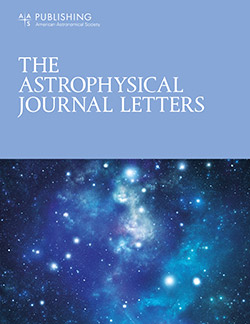Open Magnetic Fields in the Martian Magnetosphere Revealing Dipole-like Intrinsic Magnetic Fields at Mars
IF 8.8
1区 物理与天体物理
Q1 ASTRONOMY & ASTROPHYSICS
引用次数: 0
Abstract
Abstract Mars’s magnetosphere is hybrid, having contributions from both an induced magnetosphere like Venus and the localized crustal magnetic fields. However, the planetary fields also include large-scale, more global components. In this study, we investigate their role in Mars’s magnetospheric topological responses to the interplanetary magnetic field (IMF) clock angle using observations from the Mars Atmospheric Volatile and EvolutioN mission. We show that the large-scale planetary field has a “dipole-like” influence on the Mars global magnetosphere by examining the open field topology. We find that the “dipole-like” planetary field, as at Earth, results in a more open magnetosphere during southward IMF. The clock angle effects on the twisted magnetotail current sheet are similarly consistent with this analogy. It reinforces the idea that Mars’s magnetosphere and solar wind interaction are more Earth-like than previously thought.火星磁层中的开放磁场揭示了火星上偶极子样的固有磁场
火星的磁层是混合的,既有像金星一样的诱导磁层,也有局部的地壳磁场。然而,行星场也包括大规模的、更全球性的成分。在这项研究中,我们利用火星大气挥发和演化任务的观测资料,研究了它们在火星磁层拓扑响应对行星际磁场(IMF)时钟角的作用。我们表明,大规模的行星场有一个“偶极子样”的影响,对火星的全球磁层通过检查开放场拓扑。我们发现,像地球一样,“偶极子样”的行星场在向南的IMF期间导致了一个更开放的磁层。时钟角对扭曲磁尾电流片的影响与这个类比相似。它强化了火星磁层和太阳风的相互作用比之前认为的更像地球的观点。
本文章由计算机程序翻译,如有差异,请以英文原文为准。
求助全文
约1分钟内获得全文
求助全文
来源期刊

Astrophysical Journal Letters
ASTRONOMY & ASTROPHYSICS-
CiteScore
14.10
自引率
6.30%
发文量
513
审稿时长
2-3 weeks
期刊介绍:
The Astrophysical Journal Letters (ApJL) is widely regarded as the foremost journal for swiftly disseminating groundbreaking astronomical research. It focuses on concise reports that highlight pivotal advancements in the field of astrophysics. By prioritizing timeliness and the generation of immediate interest among researchers, ApJL showcases articles featuring novel discoveries and critical findings that have a profound effect on the scientific community. Moreover, ApJL ensures that published articles are comprehensive in their scope, presenting context that can be readily comprehensible to scientists who may not possess expertise in the specific disciplines covered.
 求助内容:
求助内容: 应助结果提醒方式:
应助结果提醒方式:


